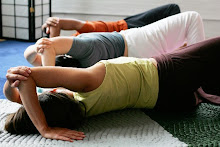 Image via Wikipedia
Image via Wikipedia
Maybe it's in your kitchen, or the desk, or the hall table. It's the drawer where all the odds and ends, the useful bits with no immediate or obvious usefulness, end up. Perhaps yours contains some paper clips, string, a bottle opener, scotch tape, a key that you can't remember exactly what it opens, so you can't throw it away. "Twistie ties," a screwdriver that never makes its way to the toolbox. Got the picture? What's in your junk drawer?
This past weekend, Feldenkrais protegee Paul Rubin visited Houston for a two-day workshop. After an Awareness Through Movement lesson, one class participant asked, "What did I just learn to do? How is that useful?" Paul's answer was profound and evocative.
He used the metaphor of the junk drawer. Each of us has one, and if you think about it, you can probably do an instant mental inventory of what you might find there. Paul said, "And you know much more, and in greater detail, what is in your junk drawer, than you know your own shoulder, or neck, or self." Might it be at least as useful to know yourself, your body, your sensations, in as much detail as you know the contents of your junk drawer?
Just as you forget what's in the junk drawer until you need something in there, and rediscover it again, certain aspects of ourselves get "filed away" because of disuse, confusion, or experience. "I'll need this someday," we tell ourselves. It's in a crisis -- where is the allen wrench? Didn't I have a crochet hook? -- that we frantically search for the perfect, simple, and elusive tool that solves our problem. Likewise, the experience of a freely floating shoulder, an easy neck, or a flexible and buoyant spine gets "filed away" after years of sitting still in a school desk or before a computer screen. The gentle and pleasurable movements we experienced as children are "filed away" in our brains, waiting to be rediscovered. When your neck feels tight, you know you should relax or release -- but how do you do that? If you knew how, you'd have done it long ago. This information is in the junk drawer.
The Feldenkrais Method provides the means so that you can know and understand yourself as well as you know what's in the metaphorical junk drawer. Some of this knowing is below the level of consciousness or cognition. This knowing comes via your senses, your emotional tone, and your experiences in action. You're bound to find something handy -- a way to move without pain, to feel more alive, to improve a skill. Gradually, you might organize the "drawer" so that you can find what you need when you need it, and get rid of the stuff that is just clutter. Your brain, your movement patterns, your physical experiences, get loaded up with a lot of junk through the years. You can streamline, travel more lightly, and get reaquainted with yourself in depth and detail you never imagined. Then, just as having the right tool for the job makes all the difference, your movement patterns contain the clues to your peak performance potential.
Moshe Feldenkrais did not intend his work to be "naval gazing" self-absorption. Nor is the Feldenkrais Method "body work" as such. The Feldenkrais Method provdes tools for better functioning, for living the life you want to live, to the best of your ability. Why keep the good stuff in the junk drawer?

![Reblog this post [with Zemanta]](http://img.zemanta.com/reblog_e.png?x-id=726ee306-f565-43ae-a480-31574e2ad524)


No comments:
Post a Comment